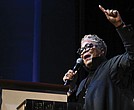Helping customers with utility bills during pandemic proves costly for city
Jeremy M. Lazarus | 7/28/2022, 6 p.m.
More than 6,300 homes and businesses in Richmond — 10 percent of the customer base — are facing disconnection of their utilities for nonpayment of water, sewer and gas bills.
April Bingham, director of the city Department of Public Utilities, delivered that information Wednesday in a report to City Council’s Governmental Operations Committee describing the problems the pandemic has created for customers and the department.
According to Ms. Bingham’s report, the effort to keep serving people during the pandemic might have been necessary, but it has been costly.
Based on the report, the department finished the 2021-22 fiscal year still waiting to receive 20 percent of payments, double the 10 percent of payments that were outstanding on the same date five years ago.
Most concerning are the number of accounts that have failed to submit payments for 90 days or more — pushing them toward the uncollectable category.
As of June 30, the department had $35.4 million in bills that had been unpaid for three months or more, or about 9 percent of revenue; in 2017, only 3 percent of bills or $10.4 million were 90 days or more past due.
For a department that projects revenue collection to top $400 million this year for the first time in the current 2022-23 fiscal year, 20 percent in outstanding bills amounts to more than $80 million.
The trouble began when the pandemic arrived, the report noted. Beginning March 12, 2020, the department responded by ending disconnections and also reconnected customers who were already past due in a bid to help prevent the spread of the COVID-19 virus and aid people after jobs were lost in the economic shutdown.
Four days later, the department suspended late fees and collection notices, and would not begin imposing late fees again until Nov. 1, 2021.
The collection problem surged, according to the report.
On June 30, 2020, uncollected bills that were 90 or more days late hit $19 mil- lion. A year later, that figure hit $28.3 million.
The report indicates that is unsustainable as it is chopping into the utility department’s financial reserves.
According to the report, the department sought to help by automatically putting customers in arrears 90 days or more on a payment plan.
By July 2020, the department had created 12,363 payment plans for customers who collectively owed $11.7 million, or an average of $921 apiece, with payments starting with as little as $5.
However, the report noted only 40 percent of customers activated their plans, while 60 percent did not and fell further behind.
The department gained help from the federal CARES Act and the American Rescue Plan, which collectively provided $19 million to cover unpaid bills.
In December 2021, the report noted that the department had repayment plans for 13,773 customers who had unpaid bills totaling about $12.5 million or $907 apiece, but only 54 percent, or about 7,440 customers had taken advantage.
That leaves more than 6,300 customers who are not paying.
Beginning in June, the department resumed disconnections of offices, stores, factories and other nonresidential buildings that were far behind and of residential customers whose service was restored in 2020 but who had not paid since. The department also resumed sending out delinquency notices.
This month, the department has been canceling the thousands of repayment plans that were never activated and re-imposing late fees on the affected accounts. Late fees are not assessed against those with active payment plans.







